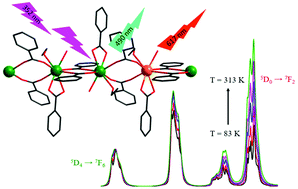Luminescence thermometry based on one-dimensional benzoato-bridged coordination polymers containing lanthanide ions†‡
Abstract
Three 1D coordination polymers with benzoate bridges have been assembled in the presence of 18-crown-6-ether (18C6): 1∞[Tb(PhCOO)3(H2O)(EtOH)]·0.5(18C6) 1, 1∞[Eu(PhCOO)3(H2O)2]·0.5(18C6) 2, 1∞[Nd(PhCOO)3(H2O)2]·0.5(18C6) 3. Compounds 2 and 3 are isomorphous. The crown ether molecules co-crystallize with the resulting 1D coordination polymers and play an important role in the supramolecular architecture of the crystals. A molecular alloy was prepared in a similar way to compound 1 using TbCl3·6H2O and EuCl3·6H2O in a molar ratio of 95 : 5. The EuIII ions have statistically substituted the TbIII ions in the host lattice The luminescence thermometry performance of the Tb0.95Eu0.05 system was investigated using pulsed excitation into TbIII absorption at 352 nm. The maximum Sr value is 1.88% K−1 at 80 K which is slightly reduced at 1.60% K−1 at 313 K. Time-gated emission spectroscopy, employed here for the first time, allows us to reduce the spectral overlap of Tb and Eu emissions in the 610 to 625 nm range by 100% at 80 K, from 18 to 9%. Compound 1 as well as the molecular alloy, Tb0.95Eu0.05, show X-ray induced luminescence.



 Please wait while we load your content...
Please wait while we load your content...